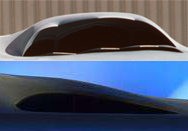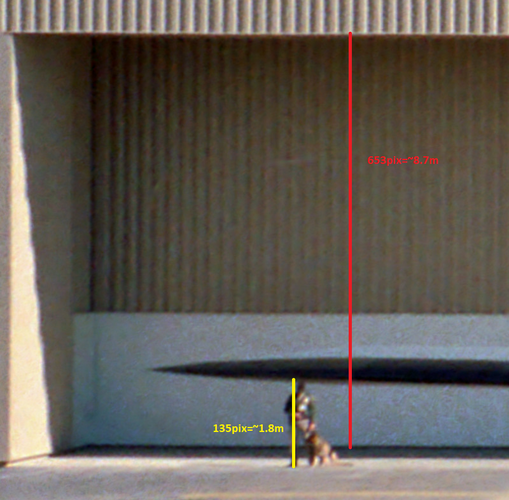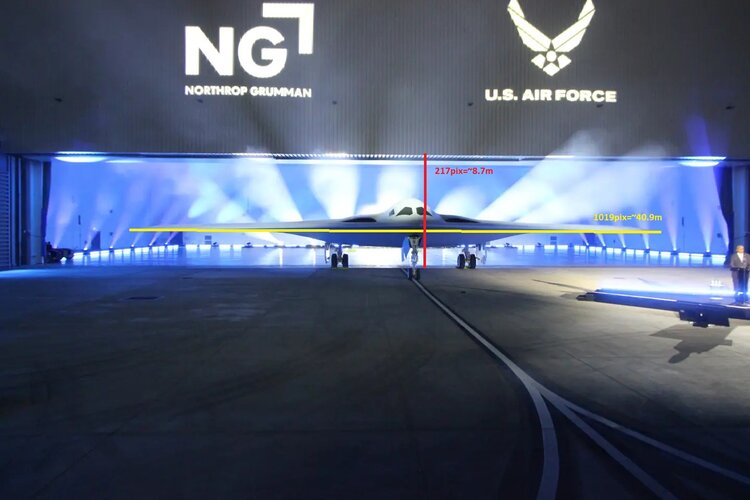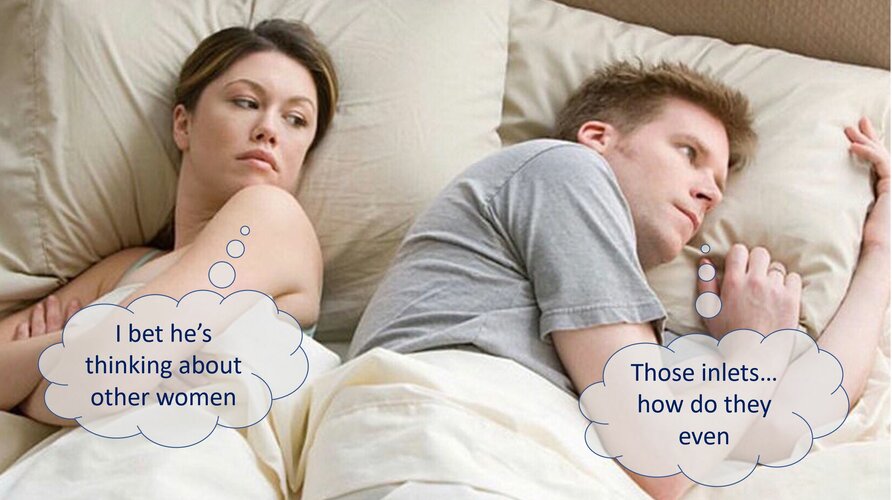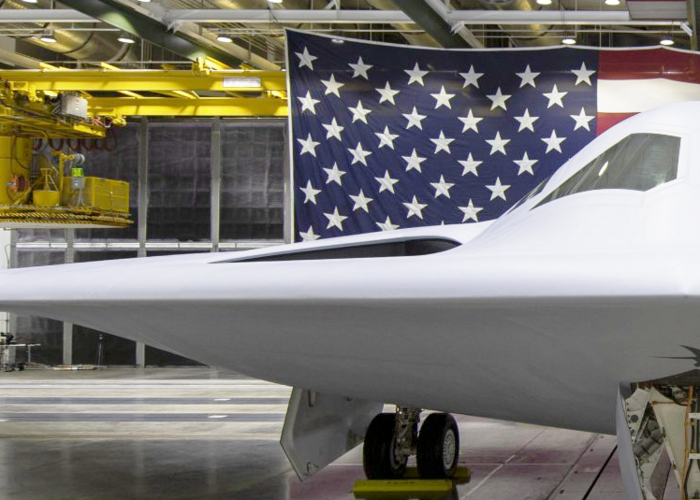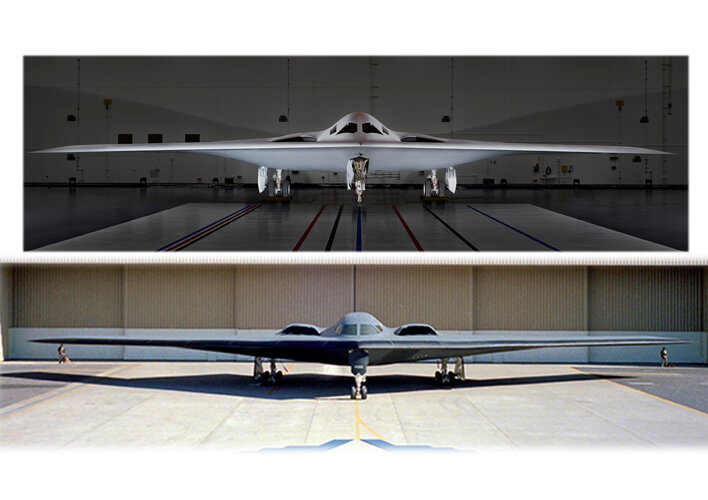You are using an out of date browser. It may not display this or other websites correctly.
You should upgrade or use an alternative browser.
You should upgrade or use an alternative browser.
Northrop Grumman B-21 Raider (LRS-B)
- Thread starter TomS
- Start date
FighterJock
ACCESS: Above Top Secret
- Joined
- 29 October 2007
- Messages
- 5,596
- Reaction score
- 5,920
Well we've seen official artwork, and now the official rollout - I guess the real question now is when is Bill Sweetman's B-21 book coming out?
It would make good company for my Bill Sweetman B-2 book.
- Joined
- 27 December 2005
- Messages
- 17,739
- Reaction score
- 26,315
Given Bill works for Northrop Grumman now, its not likely any time soon.
- Joined
- 29 September 2006
- Messages
- 1,789
- Reaction score
- 1,357
And the first plane will be officially called “War Rocket Ajax”.
- Joined
- 16 April 2008
- Messages
- 9,600
- Reaction score
- 14,470
Nobody guessed already that it could well be a tandem seater (canted windows are for the GiB).
With a super-wide opaque segment right where the pilot's head would be? No, this is side-by-side just like the B-2
Last edited:
- Joined
- 3 June 2006
- Messages
- 3,094
- Reaction score
- 3,950
According to the metadata, the picture showing the B-21 outside was taken three days ago on 2022-11-29. But IMHO this picture could have also been photoshoped.
Unfortunately for us, but quite understandable for security reasons, the press wasn't allowed to use cameras with telezoom lenses and had to put away their smartphones into lockerboxes.
Code:
Source: [MEDIA=twitter]1598928405734469634[/MEDIA]
View: https://twitter.com/ameliairheart/status/1598928405734469634?t=nqehsp9fbRyfHar3XKgTSQ&s=19Unfortunately for us, but quite understandable for security reasons, the press wasn't allowed to use cameras with telezoom lenses and had to put away their smartphones into lockerboxes.
Last edited:
- Joined
- 21 January 2015
- Messages
- 12,130
- Reaction score
- 16,288
I am baffled by your argument here, even the most cynical person is going to have a hard time getting on board with the idea of the USAF shelling out billions of dollars of taxpayers money unless it’s on the cutting edge in stealth technology for such an important mission.At best what we are seeing is lessons learned or proven tech that was demonstrated in the 80s/90s through QUARTZ and AARS. I’m not saying this isnt a feat of engineering but this is a crowd pleaser we can fly in the public domain with tech that is more than likely not as advanced as projects from 30 years ago and best case 1:1 with them. Even 1:1 I’m very doubtful on.
NG won. It wasn’t the most advanced.
- Joined
- 13 August 2007
- Messages
- 8,427
- Reaction score
- 10,936
I sleep true presentation 
my thought on B-21: It a beauty
its more voluminous then B-2A, indicate more payload ?
That big landing gear suggest it
but there was something the Secretary of Defence say that surprised me
No need for near by deployment and NO Logistics for Operation
means the B-21 could fly it missions from US soil and no need for tanker ?
It will do Reconnaissance
So that Actually a RB-21 or more ?
The B-21 will support our forces across full spectrum of operations
The B21 is multifunctional ... Gathering Intel to Battle Management ... across our join force
Now that is not typical Bomber, that sound more like Multi-combat aircraft
What combine Bomber, Reconnaissance and flying commando post !
my thought on B-21: It a beauty
its more voluminous then B-2A, indicate more payload ?
That big landing gear suggest it
but there was something the Secretary of Defence say that surprised me
No need for near by deployment and NO Logistics for Operation
means the B-21 could fly it missions from US soil and no need for tanker ?
It will do Reconnaissance
So that Actually a RB-21 or more ?
The B-21 will support our forces across full spectrum of operations
The B21 is multifunctional ... Gathering Intel to Battle Management ... across our join force
Now that is not typical Bomber, that sound more like Multi-combat aircraft
What combine Bomber, Reconnaissance and flying commando post !
Forest Green
ACCESS: Above Top Secret
- Joined
- 11 June 2019
- Messages
- 9,458
- Reaction score
- 17,267
Forest Green
ACCESS: Above Top Secret
- Joined
- 11 June 2019
- Messages
- 9,458
- Reaction score
- 17,267
zebra159357
I really should change my personal text
- Joined
- 30 November 2018
- Messages
- 99
- Reaction score
- 278
aonestudio
I really should change my personal text
- Joined
- 11 March 2018
- Messages
- 2,963
- Reaction score
- 7,481
Remarks by Secretary of Defense Lloyd J. Austin III at the Unveiling of the B-21 Bomber (A
Secretary of Defense Lloyd J. Austin III delivered remarks at a ceremony to unveil the B-21 Bomber.
www.defense.gov
FighterJock
ACCESS: Above Top Secret
- Joined
- 29 October 2007
- Messages
- 5,596
- Reaction score
- 5,920
Given Bill works for Northrop Grumman now, its not likely any time soon.
I wondered what had happened to Bill Sweetman. He had gone quiet lately. A Northrop sponsored book on the B-21 would be good though.
- Joined
- 25 June 2014
- Messages
- 1,564
- Reaction score
- 1,499
The aerodynamics of this thing fascinate me; some comment is given in the article. The hundreds if not thousands of iterative computer designs have converged on several classic historical features that are generally ignored or forgotten by the mainstream.Northrop, U.S. Air Force Roll Out the B-21 Raider | Aviation Week Network
The B-21 Raider was displayed at the company’s secretive Plant 42 complex about 34 years after a similar ceremony for its predecessor the B-2.aviationweek.com
The tailored airflow over the centre section echoes Reimar Horten's deep concern for the subtleties of the mitteneffekt (middle effect), which he never entirely resolved. He also wanted to improve the engine installation to a more conformal design.
Those intakes remind me somewhat of the NACA duct used for many small auxiliary intakes in the cold war era and trialled as an engine intake on the North American YF-93. No doubt the B-21 version is far more advanced, but the principle appears to be the same, and is I suspect the secret to decelerating the leading-edge flow at transonic speeds.
The wing outer sections have pronounced washout and, as far as I can tell, leading-edge droop. These features may be traced historically back through the majority of tailless swept wings, including the production Convair deltas, Avro Vulcan and Horten types, to the Dunne machines of the pioneer era and his 1909 patent. The first such design to fly, the D.5 biplane of 1910, received the first ever official certificate of performance for a stable aeroplane. Twenty or so years after that Ludwig Prandtl developed the theory of the bell-shaped lift distribution which offers the lightest structure and lowest drag for any given wing size, and for which these two features are necessary. Lippisch published a simplified calculation, which Horten adopted (though for some reason Lippisch seldom did). NASA only publicly caught up in this millennium, with Jonathan Bowers' PRANDTL-D flying wing project. Clearly, the key benefit for the digitally-controlled B-21 is not the inherent stability but Prandtl's minimal weight and drag. Once you sweep the wing, the stability comes with that package. Also of interest is that, right up to his rediscovery by Bowers, Prandtl was ignored by the mainstream and it was believed that these design features increased drag; this was voiced as a major criticism of the Dunne, and Northrop never incorporated them, not even in the B-2. Now, we see that they actually enhance the B-21's low drag characteristics.
The question I ask myself now is, did Northrop Grumman secretly take forward all these long-known but also long-obscure aerodynamic features, or did their computers arrive at something they knew nothing of beforehand? Either way, the B-21 looks like becoming a major vindication of all those maverick forebears.
Last edited:
red admiral
ACCESS: Top Secret
- Joined
- 16 September 2006
- Messages
- 1,805
- Reaction score
- 2,374
People design aeroplanes. Not computers. They are simply another analysis tool like wind tunnels, or glueing tufts on the outside. You use the tools to assess and provide evidence for decisions. You don't just press enter on the computer.
Features may look similar, but the rationale may be very different because it depends on the specific design goals and your geometrical constraints. e.g Dunne in 1910s wasn't trying to design a jet powered, transonic, stealthy aircraft
Features may look similar, but the rationale may be very different because it depends on the specific design goals and your geometrical constraints. e.g Dunne in 1910s wasn't trying to design a jet powered, transonic, stealthy aircraft
- Joined
- 3 June 2011
- Messages
- 18,327
- Reaction score
- 12,193
Doesn't look like it would have the room to carry it internally.No way that thing could even carry one MOP let alone two.
What from the reveal makes you think this thing couldn't carry even a single MOP? Based off the pictures we have it's only slightly smaller and if the rumors of it having two non-afterburning F135s are true it'll have about 85% of the thrust of the B-2. That all combines to it being able to carry at least one MOP.
Edit: Also, based off photos of the B-21 and B-2 reveals it seems the main landing gear for the B-21 is at about the same width as the B-2. Might mean two bomb bays (probably with two rotary launchers) like the B-2, or might mean nothing.
- Joined
- 3 June 2011
- Messages
- 18,327
- Reaction score
- 12,193
I'd rather they built something that could handle worse case. If we go to war with China it will be a bit late to start building bombers then.Based on the last decade or two of experience, I'm being realistic about the kinds of conflicts we'd actually be willing to get involved in...Why would you need a B-21 to hit anything in Syria?Screwed with one side, left the other alone. Blue points to apparent intake duct, red points to apparently solid bit. Interesting. It occurs to me that the intakes curving inward may suggest that the engines are a bit closer together - this may be of benefit in a two-engine aircraft if an engine goes out. I have now spent way too much time being amused by an overexposed image of an intake.
Also: "it might not carry as much/carry MOP/etc." Well what sort of warload do you need to whack targets in Syria anyway?
I decided to do some pixel counting on the photos.
I used the B-2 photo in front of that hangar posted by Maro Kyo (post#3164) to estimate that the hangar door is roughly 8.7m high. I am calculating the height instead of the width of the door, because it enables taking the measurement in the less distorted center part of the image. I used the man standing close to the door as a reference, since using the B-2 as a reference is not accurate, because it is so much closer to the camera so you would have size distortion from perspective relative to the hangar door.
Combining the estimated height with this relatively low distortion picture of the B-21, I am getting a ~40.9m wingspan for the Raider. The wingtips of the bomber are at roughly the same distance from the camera as the door hole of the hangar, which minimizes size discrepancies due to perspective. However, there is still clearly some fish eye type perspective distortion, since the bomber is a large object, and the photo is taken from relatively nearby with a short focal length camera. Using the same method on another picture I got ~41.7m, but I will refrain from posting it to keep the attachment sizes down since it doesn't add much.
If they keep this thing inside, we might have to wait a while for the definitive answer from satellite photos.
I used the B-2 photo in front of that hangar posted by Maro Kyo (post#3164) to estimate that the hangar door is roughly 8.7m high. I am calculating the height instead of the width of the door, because it enables taking the measurement in the less distorted center part of the image. I used the man standing close to the door as a reference, since using the B-2 as a reference is not accurate, because it is so much closer to the camera so you would have size distortion from perspective relative to the hangar door.
Combining the estimated height with this relatively low distortion picture of the B-21, I am getting a ~40.9m wingspan for the Raider. The wingtips of the bomber are at roughly the same distance from the camera as the door hole of the hangar, which minimizes size discrepancies due to perspective. However, there is still clearly some fish eye type perspective distortion, since the bomber is a large object, and the photo is taken from relatively nearby with a short focal length camera. Using the same method on another picture I got ~41.7m, but I will refrain from posting it to keep the attachment sizes down since it doesn't add much.
If they keep this thing inside, we might have to wait a while for the definitive answer from satellite photos.
Attachments
seruriermarshal
ACCESS: Top Secret
- Joined
- 4 May 2008
- Messages
- 1,180
- Reaction score
- 574
what's aircraft in the first pic ?
View: https://twitter.com/ChiefofAirStaff/status/1598918086408957952
View: https://twitter.com/ChiefofAirStaff/status/1598918086408957952
I think it looks chonkier because it's overall smaller. I think the bomb bay is the same as on B-2. I also think the peanut gallery decrying lost capability is also completely wrong.its more voluminous then B-2A, indicate more payload ?
That big landing gear suggest it
In the 30 years from B-2 to this thing, we have gotten much better at making every single part of the aircraft and especially the structure. It's going to burn less fuel for the same thrust because the engines are more efficient, and require less thrust for the same speed because it's smaller and less draggy, so it needs to carry less fuel. It weighs a lot less because it's smaller, and also because composite structures have become dramatically lighter and stronger since the 80's. Remember, B-2 isn't even fully composite structure, because the state of the art back then didn't allow it. RAM coatings have seen multiple generations since the B-2 was designed, and while most of that was capability and durability, I'd take the bet that the modern stuff is also lighter.
I'm going to bet that it's smaller because it can be, as in, mission requirement was to match the payload and range of the B-2 and NG was able to do it with a much smaller package. We won't know if that's true for many years yet.
How are you arriving at that conclusion?Doesn't look like it would have the room to carry it internally.
Note that the line of the fuselage on top is different from B-2 near the engines. Unlike with B-2, where the engine pods are separate from the central fuselage and there is a "valley" between them, on B-21 the central fuselage starts directly from the engines. This makes the payload bay proportionally substantially larger. Add to that the increased chonk on the bottom of the plane, and frankly, I'm going to bet that the total payload bay volume is not smaller than B-2.
TIME :

 time.com
time.com


Exclusive: The Making of the Military's New Stealth Bomber
The U.S. is making a massive, strategic gamble that hasn't paid off in the past
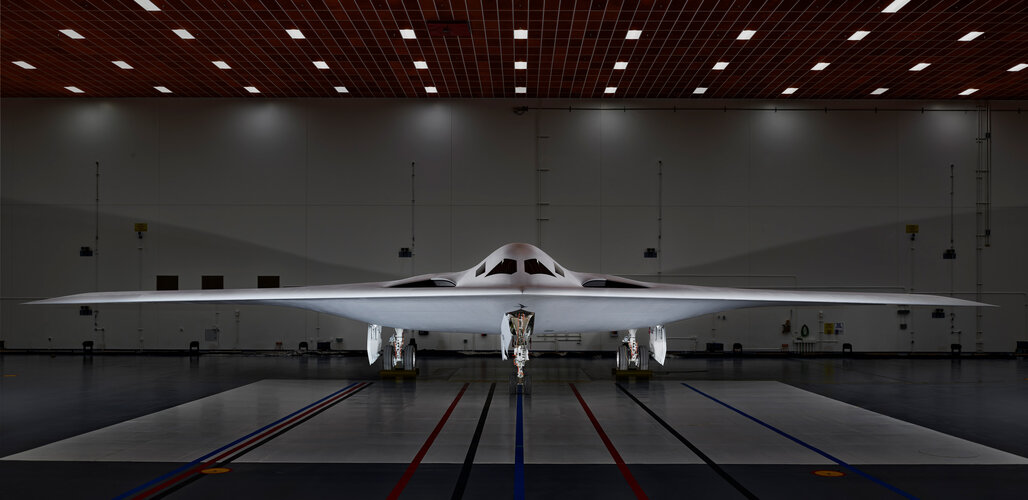
As I said, the space between main landing gear looks basically the same to me so it should have the same amount of space for weapons bays as the B-2. But even assuming it only has space for half the payload, they're still going to design its one weapons bay to carry one MOP.Doesn't look like it would have the room to carry it internally.
This Time Article had a picture of a guy standing inside a composite duct with a cap on. I did some pixel measurements based on the assumption that the cap rim is 19cm wide (measured one that I have). This gives the duct a diameter of 43.5in, which corresponds very closely to the fan size of the F135.TIME :

Exclusive: The Making of the Military's New Stealth Bomber
The U.S. is making a massive, strategic gamble that hasn't paid off in the pasttime.com
So it looks like it is two engines.
Attachments
- Joined
- 21 January 2015
- Messages
- 12,130
- Reaction score
- 16,288
Every time I see a new image of it, it just looks more and more like a fifties flying saucer.TIME :

Exclusive: The Making of the Military's New Stealth Bomber
The U.S. is making a massive, strategic gamble that hasn't paid off in the pasttime.com
View attachment 688303
- Joined
- 17 October 2006
- Messages
- 2,393
- Reaction score
- 1,196
what's aircraft in the first pic ?
SG-2 (NG's MQ-Next bid)
Last edited by a moderator:
- Joined
- 17 October 2006
- Messages
- 2,393
- Reaction score
- 1,196
Well yes it would.Every time I see a new image of it, it just looks more and more like a fifties flying saucer.TIME :

Exclusive: The Making of the Military's New Stealth Bomber
The U.S. is making a massive, strategic gamble that hasn't paid off in the pasttime.com
View attachment 688303

martinbayer
ACCESS: Top Secret
- Joined
- 6 January 2009
- Messages
- 3,384
- Reaction score
- 3,876
The upper inlet lips seem to vary in thickness though at the point of the inlet discontinuity, so I'd guess it's a permanent feature.They look like blanking plates so you can't see the inlets.Is it me or does the outer portion of the inlet look solid?Ramping up the brightness in the dark spots doesn't reveal a whole lot.View attachment 688241
Additional thought: If they REALLY wanted to keep people guessing about the intakes, they could easily have done the rollout with red air intake cover plates in place...
Last edited:
More like the B-21 was based on Shikaka.So the B-21 was the White Bat?
BDF
ACCESS: Secret
- Joined
- 14 March 2009
- Messages
- 284
- Reaction score
- 424
Very interesting jet for sure. Those inlets are incredible. So the theory of a 2/3rds B-2 appear to be correct. My semi-WAG is 215-230Klbs GTOW, empty weight in the 82-85Klbs with a max payload of 26-28Klbs. Internal fuel around 95-100Klbs. Maybe has a couple bays with the ability to use two rotary launchers of six 2klb munitions each for a max of 12. Just gotta buy a lot of these
- Joined
- 3 June 2011
- Messages
- 18,327
- Reaction score
- 12,193
I hope those bays are bigger than that.Very interesting jet for sure. Those inlets are incredible. So the theory of a 2/3rds B-2 appear to be correct. My semi-WAG is 215-230Klbs GTOW, empty weight in the 82-85Klbs with a max payload of 26-28Klbs. Internal fuel around 95-100Klbs. Maybe has a couple bays with the ability to use two rotary launchers of six 2klb munitions each for a max of 12. Just gotta buy a lot of these
Avimimus
ACCESS: Top Secret
- Joined
- 15 December 2007
- Messages
- 2,426
- Reaction score
- 906
The question I ask myself now is, did Northrop Grumman secretly take forward all these long-known but also long-obscure aerodynamic features, or did their computers arrive at something they knew nothing of beforehand? Either way, the B-21 looks like becoming a major vindication of all those maverick forebears.Northrop, U.S. Air Force Roll Out the B-21 Raider | Aviation Week Network
The B-21 Raider was displayed at the company’s secretive Plant 42 complex about 34 years after a similar ceremony for its predecessor the B-2.aviationweek.com
That is quite the question. It'll keep me up at night for a bit
From someone that attended the rollout
pedrospe
ACCESS: Secret
- Joined
- 9 February 2010
- Messages
- 395
- Reaction score
- 214
Just making a rude comparison between the B-2 and the B-21.From someone that attended the rollout
Attachments
Last edited by a moderator:
Well, looking at the two workers(?) in the background, compare them against the people who were walking with the B-21 when they rolled it out. Unless they're drastically different heights, I'd say the B-21 is smaller than this comparison makes it seem.Just making a rude comparison between the B-2 and the B-21.
Last edited by a moderator:
- Joined
- 1 April 2006
- Messages
- 11,373
- Reaction score
- 10,198
I decided to do some pixel counting on the photos.
I used the B-2 photo in front of that hangar posted by Maro Kyo (post#3164) to estimate that the hangar door is roughly 8.7m high.
I doubt hangars are the same looking at taxiway markings.
Similar threads
-
USAF to Retire B-1, B-2 in Early 2030s as B-21 Comes On-Line
- Started by flateric
- Replies: 323
-
-
-
-

